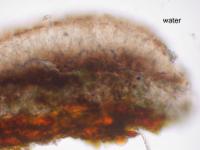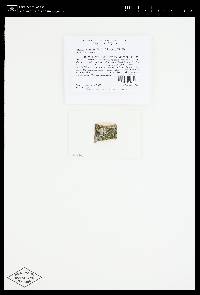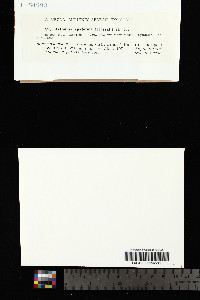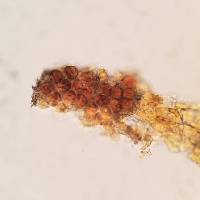
Consortium of Lichen Herbaria
- building a Global Consortium of Bryophytes and Lichens as keystones of cryptobiotic communities -
- Home
- Search
- Images
- Species Checklists
- US States: O-Z >
- US National Parks
- Central America
- South America
- US National Parks
- Southern Subpolar Region
|
|
|
|
Family: Arthoniaceae
[Allarthonia apatetica (A. Massal.) Lettau, moreArthonia exilis var. apatetica (A. Massal.) J. Nowak, Catillaria apatetica A. Massal., Coniangium apateticum (A. Massal.) A. Massal.] |
Nash, T.H., Ryan, B.D., Gries, C., Bungartz, F., (eds.) 2007. Lichen Flora of the Greater Sonoran Desert Region. Vol 3. Life habit: lichenized Thallus: inconspicuous;vegetative hyphae: 2-3 µm thick, the thicker ones usually brownish pigmented, loosely growing between the algal cells, but tightly arranged on the surface of the photobiont photobiont: chlorococcal algae (probably Trebouxia) epihymenium: pale brown, 8-12 µm thick, composed of branched hyphae in gelatinous matrix with granules hymenium: pale brown, 40-50 µm; paraphysoids: slender, c. 1 µm thick but of variable thickness; subhymenium: pale brown asci: clavate, 30-40 x 18-22 µm, 8-spored, laterally thin-walled ascospores: hyaline, 1-septate (incised at septum), obovate (upper cell broader), 10-13 x 4-5 µm, with very thin gelatinous sheath (distinctly swelling in K) Pycnidia: not seen Chemical reactions: hymenium I+red, KI+blue; ascus tholus with KI+ ring and pale blue flanks; gelatinous sheath of ascospores KI-. Substrate and ecology: more frequently found on base-rich and soft bark in sheltered situations World distribution: probably widespread, but overlooked. Europe, North America. Sonoran distribution: Sonora. Notes: There is some confusion about A. apatetica and its relationships to similar species, all representing the Arthonia exilis group. While A. exilis differs by having stout paraphyses (Coppins 1983), the similar A. muscigena is usually distinguished by its narrower (and in average shorter) ascospores measuring 8-12 x 2.5-4 µm. It may, however, be misleading to rely entirely on measurements from too few samples. Each specimen has rather narrow range of spore sizes which does not represent the full variation within species. The correlation with other characters may clarify this species complex in the future. Specimens found on living leaves that were treated under A. microsticta (frequently associated with Fellhanera spp.) can usually be assigned to A. muscigena according to Sérusiaux (1996); he could also not rule out whether the type of A. microsticta is distinguishable at the species level. Another name of a lichen closely related to Arthonia apatetica is A. perparva, known only from the type in New Zealand on Podocarpus leaves (Matzer 1996). Arthonia patellulata, also with coccal green algae, differs clearly by having larger ascomata with excipuloid layers, a rather dark subhymenium, and in occurring in cool-temperate to boreal-montane habitats. |
|
|
|
Powered by Symbiota

































































